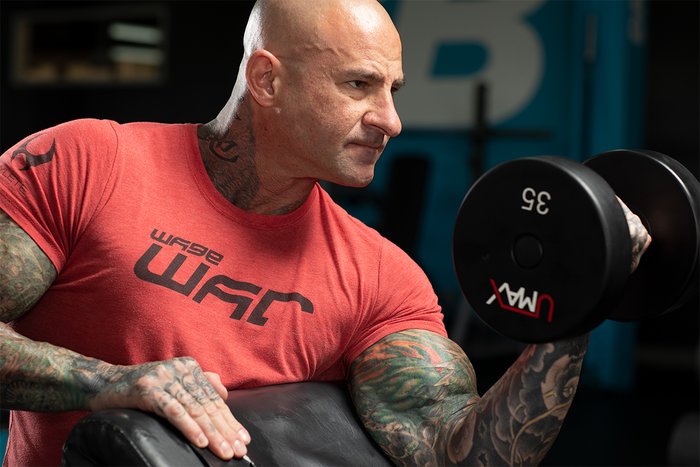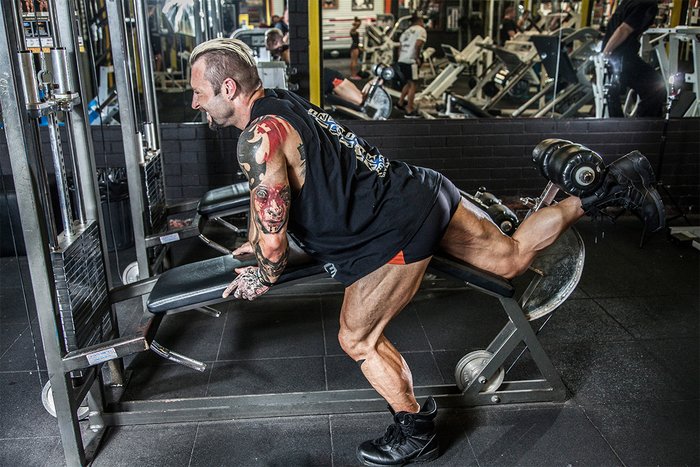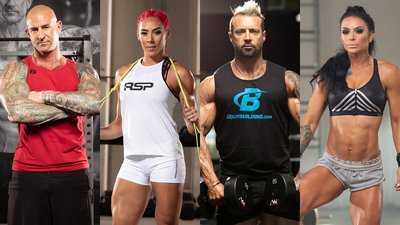You can get some results by changing a little of what you do for the better. But to sculpt your best-ever physique, you need a sound overall approach. You need to select a well-designed workout plan—and then stick to it, even when you don't feel like it. Work hard, eat the right foods, stay hydrated, and get all the sleep you need (and maybe more). Along the way, soak up all the tips you can from the experts.
That way, your end point isn't just some "after" picture on a day when you look especially lean, it's looking in the mirror and knowing that an experienced, equipped lifter is staring back at you. Your "after" is really just the beginning of something far bigger.
Bodybuilding.com's BodyFit training plans are created by some of the world's best trainers. Jay Cutler, Hannah Eden, Kris Gethin, Ashley Horner, Jim Stoppani—these are just a few of the outstanding coaches who will walk you through their workouts and programs. They'll also each share hard-earned tips and tricks along the way to help you get the most out of each set and rep.
Whether you're looking for the incinerating cardio and plyometrics of Hannah Eden's FYR, the pure muscular power of Jay Cutler and Kris Gethin, the weekly missions launched by Ashley Horner, or Jim Stoppani's explorations into the scientific basis of muscle building, BodyFit has it all. All you need to do is choose the one that's right for you, and start hitting the gym. Here are a few tips to get you started down the road to complete transformation!
Tip 1: Don't Limit Yourself to a Single Version of Periodization
It's a tale as old as time: You can lift a weight for a solid set of 8-10, so you add another small plate. And another. You get stronger, and you start seeing muscle where there wasn't any before.
It should keep progressing like this forever, right? Alas, it doesn't. Eventually, the strength and size gains that seemed so easy at first grind to a halt—and maybe even slip backward. When the weights can't get any heavier, the true art of exercise programming begins.

"If your gains have stagnated, try changing up your training at specific times to maximize results," says Jim Stoppani, Ph.D., the force behind Shortcut to Size and Shortcut to Strength.
Both programs tweak the crucial variables that allow you to keep moving forward—not only sets and reps, but also exercise selection, rest periods, and exercise order, among others. Master the subtle dance between these, and you can truly keep progressing for years.
Tip 2: Think "Cardio Acceleration," Not Just Cardio
If you want to add muscle, lift hard and rest between sets. If you want to lose weight, do cardio. So says the traditional way of doing things. And sure, this approach can help you make some progress, but to really chase fat away, mix strength and cardio with what Stoppani calls "cardio acceleration."
"Instead of resting between your lifts, do high-intensity cardio between every single lift to fire up your fat-burning furnace," Stoppani advises in the third pillar of his BodyFit triumvirate, Shortcut to Shred.
Of course, picking the appropriate exercise is paramount here. The right pick will help every workout be more effective. The wrong pick can ruin an otherwise perfect workout. When in doubt, go for non-competing body parts. So, bench press with bench step-ups is great, but bench press with battling ropes is only going to fry your upper body for your presses.

Tip 3: Exercise at a Pace That Makes Sense for You, Not Someone Else
"There's nothing to be gained by trying to keep up with someone who is on a completely different level than you. Find your own speed," says Hannah Eden, a highly sought-after trainer, entrepreneur, and philanthropist who works with top-tier fitness organizations including Reebok, Men's Health Magazine, and Lululemon.
What does this mean for you? Sure, you can destroy yourself every day trying to keep up with an elite athlete's program or follow-along workout, but any gains you have are going to be temporary at best. And, once you get burned out and need a week or two off, it's that much harder to get started again.
A better way is to be honest about your ability level, especially in the early going. In FYR: Hannah Eden's 30-Day Fitness Plan, she offers three levels of follow-along intensity. Yes, it's tempting to try to keep up with the highest level, which is Hannah herself, the first time through the program. No, we don't recommend it.
Tip 4: Don't Be Afraid of High Reps
The traditional model of lifting says to do low reps for strength, medium reps for muscle growth, and higher reps, like 12-20 per set, for "endurance," whatever that is.
So, what do you call it when, in Kris Gethin's massively popular 12-Week Muscle Building Trainer, you start off a leg day with sets of 50, 40, and 30 on the leg extension, followed by sets of up to 30 on the leg press and hack squat? Kris calls it the Dramatic Transformation Principle, or DTP, and your body has never experienced anything like it. Even if you've tried one of those old-school 20-rep squat protocols (everybody has once, right?), this will blow your mind while it blows up your quads.
Gethin swears by DTP as the way to "maximize your body's ability to build muscle." But be warned: you achieve that maximization by pushing your body to its limit. Yes, you'll have to rest-pause your way through some epic sets. Yes, screaming and grunting is inevitable, and having a bucket handy is probably a good idea. But, if you hit your reps and eat enough, growth is inevitable.
Tip 5: There's No Substitute for the Mind-Muscle Connection
Lifters love to compare numbers on big compound lifts like bench, squats, and deads, and for good reason. But don't forget that big strength is the product of being able to control lots of smaller moving parts.
Translation? Don't skip isolation work, and when you do it, make sure you're really focusing on feeling the right muscles working—what is known as the "mind-muscle connection." The old-time strength masters knew the importance of this concept. The golden-age bodybuilders swore by it. And Gethin is a big believer in its power to help anyone and everyone transform their physique.
"Doing exercises that isolate individual muscles helps you tune in to each muscle, which can help you maintain strict form when doing compound exercises," says Gethin in his 12-Week Hardcore Daily Video Trainer.

Plus, it'll help you add muscle while you're getting stronger—and there's absolutely nothing wrong with that.
Tip 6: Know Your Max, Even If You Don't Test It Regularly
Go into any weight room on any day, and you'll see someone who seems like they're hell-bent on seeing just how much weight they can push in a single rep. And next time they come to the gym, they'll be doing the same thing—over and over again, until an injury stops them in their tracks.
This person has mistaken "displaying strength" with "building strength." No, they're not the same thing! But don't let them stop you from seeing the value in knowing what your one-rep max (1RM) is, though. Doing a test on a few major lifts once or twice a year—or just when you start a seriously kick-ass program—is essential for dialing in your programming and helping your body get the message to change for the better.
And this doesn't just apply to powerlifters. Ashley Horner, a fitness model, mother, and all-around badass athlete and entrepreneur, directs every woman (and man) who starts her Charlie Mike 6-Week Fitness Plan to test their max bench press, back squat, push press, and deadlift at the start and end of the program.
"Once you've established your 1RM, you've found a tried-and-true way of tracking your progress and getting the most out of your training time," Horner says.
Make no mistake, there's a lot of sweating and brutal metcons in between the start and finish lines, not just pure strength work. But having these objective benchmarks in your file will help everything between them be better.
Don't feel up for a grinding max-effort rep? No problem. Determine what you can handle for 3 rock-solid reps with perfect form, and then plug it into a one-rep max calculator to give you a "good enough" estimate.
Tip 7: Train Your Mind as Hard as You Do Your Body
Despite a rock-solid foundation of great genetics, Jay Cutler didn't wake up one morning with 22.5-inch arms and a barn-door back. He's been competing in the iron game for 20 years—even though people may remember those four Mr. Olympia titles and three Arnold Classic crowns most. He built his massive physique with two decades of hard work and heavy lifting, doing it when nobody was watching, and often when nobody but him cared.
Yes, it's a long and sometimes lonely road. But, if you love it and live it, then after a while it doesn't feel that way—it's just what you do.
"The mentality of a bodybuilder isn't normal. Something has to be triggered inside you—a desire to always push yourself beyond the limits," explains Cutler.
Even years after he's retired, millions still follow Cutler across social media, use his every post as inspiration, and follow his Living Large: 8-Week Mass Trainer to feel what he felt.
"The secret is progression. Consistency. Dedication. Day in, day out," Cutler says.



